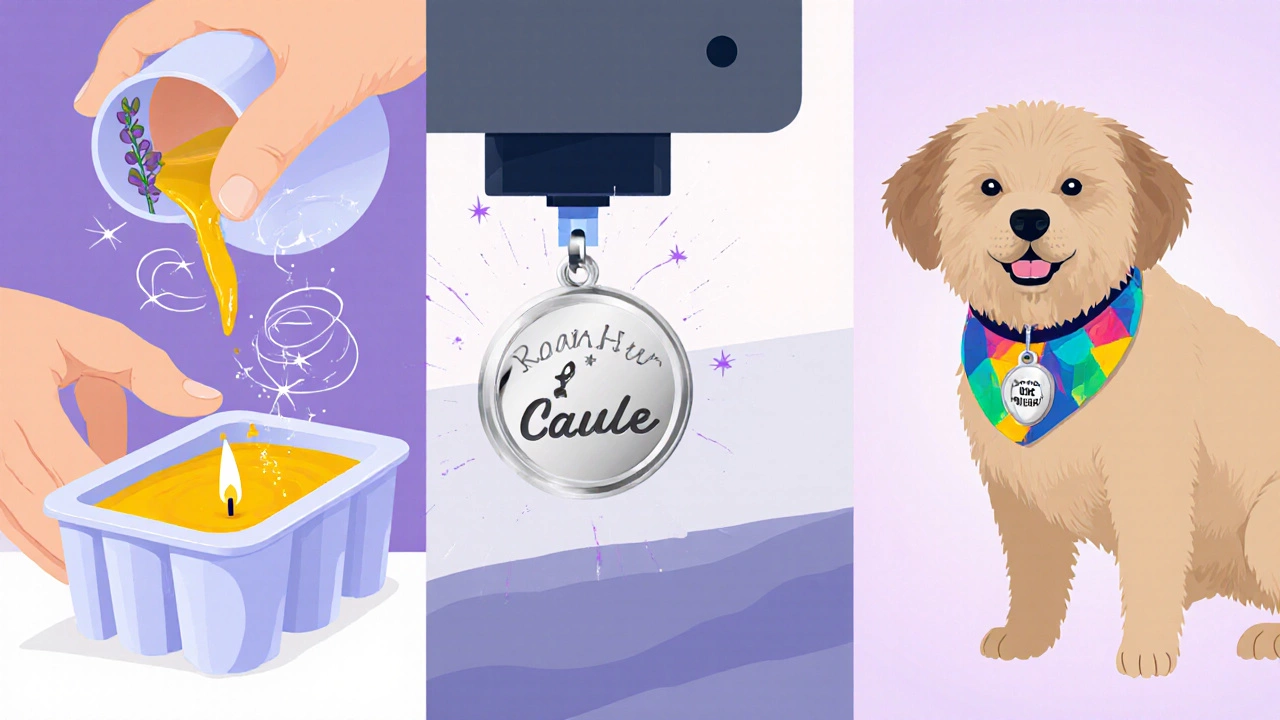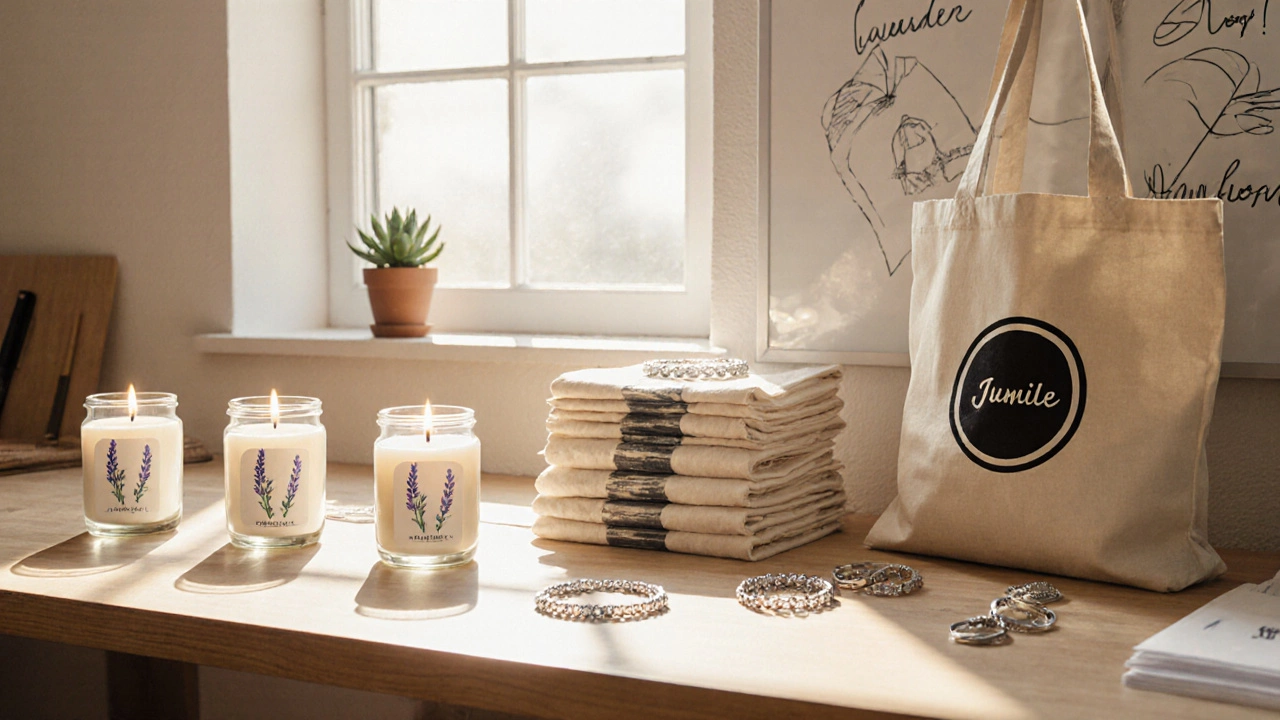Craft Business Profitability Calculator
Calculate Your Profitability
Enter your craft business details to see if your product meets the 40%+ profit margin threshold.
Recommended: Target at least 40% profit margin
For reference: Eco-friendly tote bags average 65% margin
Compare with Popular Crafts
£150-£300 startup
£200-£400 startup
£250-£500 startup
£100-£250 startup
£300-£600 startup
Quick Takeaways
- Handmade candles, personalized jewelry, and custom pet accessories dominate 2025 sales.
- Initial investment can be as low as £150 for a candle line.
- Profit margins above 50% are common for eco‑friendly tote bags.
- Social media platforms (TikTok, Instagram) drive the biggest traffic spikes.
- Starting small, testing a niche, then scaling with wholesale partners is the safest route.
hottest selling craft is the craft product that generates the highest sales volume and profit margin in a given period, usually driven by a mix of consumer trends, low production cost, and strong online visibility. In 2025 the market is buzzing around a handful of crafts that check all those boxes. Below we break down why they soar, how you can evaluate their profitability, and the exact steps to launch your own line.
Why Some Crafts Outperform Others
Three forces shape the craft market today:
- Trend alignment: Products that echo sustainability, personalization, or pet‑centric lifestyles tap into consumer emotions.
- Production simplicity: Crafts that need minimal machinery and can be produced in a home‑based workshop keep overhead low.
- Online discoverability: Items that photograph well and create shareable moments explode on TikTok and Instagram.
When a craft hits all three, sales spike and the product becomes the ‘hottest selling craft’ of the season.

Top 5 Hottest Selling Crafts in 2025
Below are the five crafts that consistently rank at the top of sales dashboards across UK marketplaces like Etsy, Not on the High Street, and Amazon Handmade.
Handmade candles
Consumers love scented candles for home ambience and gifting. The key to success is unique aromatics (e.g., “Yorkshire Lavender”) and eco‑friendly soy wax. Startup cost: £150‑£300 for wax, molds, and basic branding. Median profit margin: 55%.
Personalized jewelry
Custom name necklaces, birth‑stone rings, and engraved bracelets hit the sweet spot of sentiment and fashion. With a small laser engraver (£500) you can scale quickly. Initial outlay: £200‑£400 for materials and tools. Median profit margin: 60%.
Custom pet accessories
From hand‑stitched bandanas to 3‑D‑printed pet tags, pet owners spend heavily on unique items for their furry friends. Production can be split between sewing (low cost) and 3D printing (moderate cost). Startup budget: £250‑£500. Median profit margin: 50%.
Eco‑friendly tote bags
Reusable bags made from organic cotton or up‑cycled materials ride the sustainability wave. They’re easy to print with heat‑transfer designs. Startup cost: £100‑£250 for fabric and a small heat press. Median profit margin: 65%.
Resin art pieces
Resin coasters, river tables, and decorative mouldings combine visual appeal with durability. The learning curve is steeper, but the market rewards unique designs. Equipment cost: £300‑£600 for resin, moulds, and safety gear. Median profit margin: 45%.
How to Evaluate a Craft’s Profitability
Before you invest, run a quick profitability checklist:
- Material cost per unit: Calculate the exact cost of raw materials, including wastage.
- Labor time: Estimate minutes per item and assign a reasonable hourly rate.
- Pricing ceiling: Research similar listings on Etsy and see the highest price that still sells.
- Volume potential: Look at search volume for the craft keyword using tools like Ahrefs or Google Trends.
- Scalability: Can you automate any step (e.g., batch pouring for candles) without compromising quality?
If the projected margin exceeds 40% and the keyword shows upward trend, the craft qualifies as a strong candidate.
Step‑by‑Step Guide to Launch a Craft Business
- Pick a niche: Choose one of the top‑selling crafts above or a sub‑niche (e.g., “herbal soy candles”).
- Prototype and test: Make a small batch (10‑15 units) and gather feedback from friends or local craft fairs.
- Brand basics: Register a simple name, design a logo, and create a cohesive colour palette.
- Set up an online shop: Use Etsy for quick start, then add a Shopify store for branding control.
- Photograph professionally: Natural light, simple backgrounds, and lifestyle shots boost conversion.
- Launch with a limited‑time offer: Discount or free shipping for the first 20 orders to generate reviews.
- Scale via wholesale: Approach boutique retailers with lookbooks once you have consistent sales.
- Iterate: Use sales data to refine scents, designs, or packaging each quarter.
Following this roadmap reduces risk and gives you a clear path from hobby to profitable micro‑enterprise.
Common Pitfalls and How to Avoid Them
- Underpricing: New crafters often price based on material cost alone. Add labor, overhead, and a profit margin.
- Ignoring regulations: Candle makers must comply with fire safety labeling; jewelry makers should be aware of metal purity standards.
- Poor inventory control: Keep a simple spreadsheet tracking raw material levels to avoid stock‑outs.
- Neglecting SEO: Use long‑tail keywords like “hand‑poured lavender soy candle UK” in titles and tags.
- Skipping customer service: Fast replies and pleasant packaging turn one‑off buyers into repeat customers.
Comparison of the Hottest Selling Crafts (2025)
| Craft | Initial Investment (GBP) | Average Profit Margin | Trend Score (2024‑25) | Skill Level Required |
|---|---|---|---|---|
| Handmade candles | £150‑£300 | 55% | 9/10 | Low |
| Personalized jewelry | £200‑£400 | 60% | 8/10 | Medium |
| Custom pet accessories | £250‑£500 | 50% | 8/10 | Medium |
| Eco‑friendly tote bags | £100‑£250 | 65% | 9/10 | Low |
| Resin art pieces | £300‑£600 | 45% | 7/10 | High |
Frequently Asked Questions
Which craft requires the lowest startup cost?
Eco‑friendly tote bags generally need the smallest budget-around £100 for fabric, a basic heat press, and simple printing supplies.
Do I need a business licence to sell handmade crafts in the UK?
For a home‑based operation you can register as a sole trader with HMRC. If you hire employees or exceed the VAT threshold, you’ll need additional registrations.
How fast can I expect to see sales on Etsy?
With strong photos and SEO‑optimized listings, many sellers report their first sale within 1‑2 weeks of launching.
Is it worth investing in a laser cutter for personalized jewelry?
A mid‑range laser cutter (£500‑£800) can dramatically increase production speed and allow intricate designs. It pays off after about 300‑400 units sold.
What are the best channels for marketing my craft products?
Short‑form video on TikTok, lifestyle reels on Instagram, and Pinterest boards for visual discovery drive the most traffic for handmade items.
Whether you gravitate toward scented candles or eco‑friendly tote bags, the core formula stays the same: pair a clear trend with low‑cost production, showcase it visually, and let social platforms do the heavy lifting. Choose one of the crafts above, run the profitability checklist, and start small. In a few months you could be riding the wave of the next hottest selling craft and turning a hobby into a steady income.
